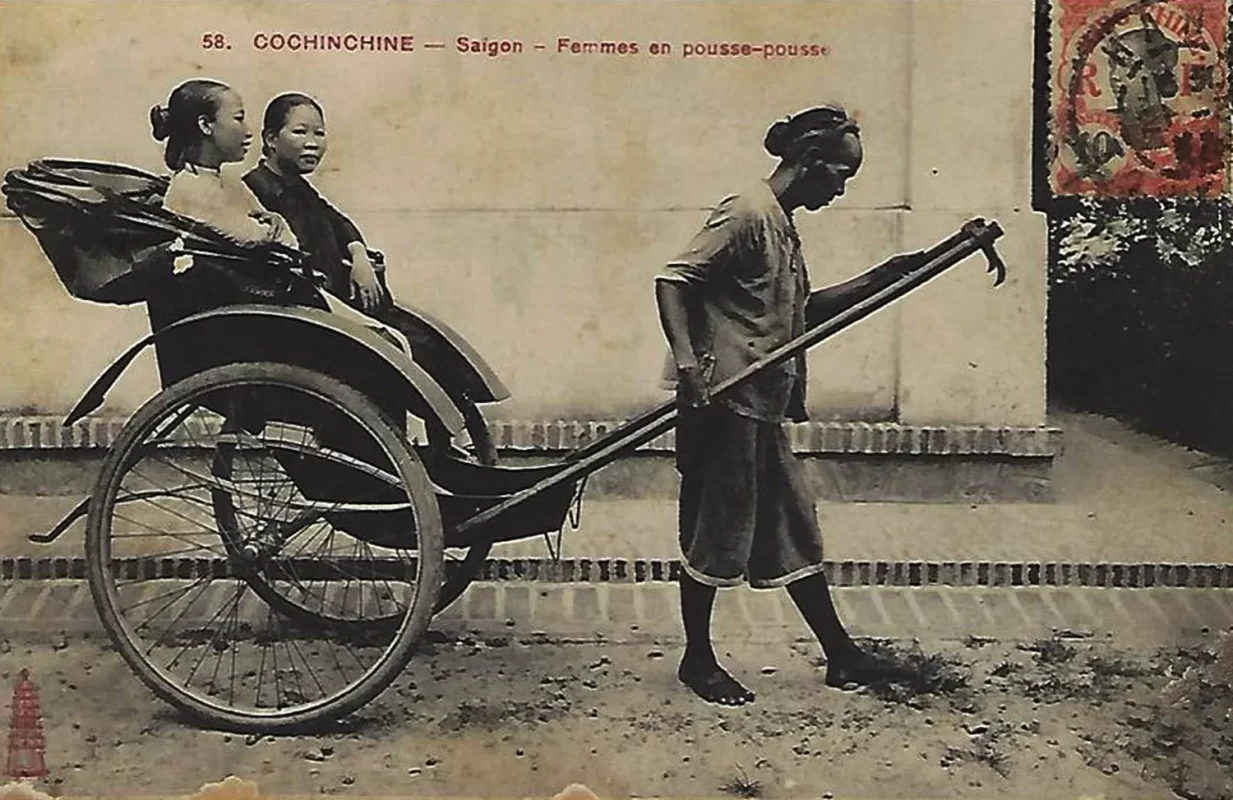In the vibrant tapestry of Vietnam’s urban landscape, few symbols capture the country’s unique blend of tradition and adaptation quite like the cyclo. This distinctive three-wheeled vehicle, with its passenger seat positioned in front of the cyclist, has become an enduring cultural icon that tells the story of Vietnam’s complex journey through the 20th century and beyond. At Viet Rice Essence Restaurant and Viet Rice Kitchen Cooking Class, we often recommend cyclo tours to our guests as one of the most authentic ways to experience Vietnamese cities and their rich cultural heritage.
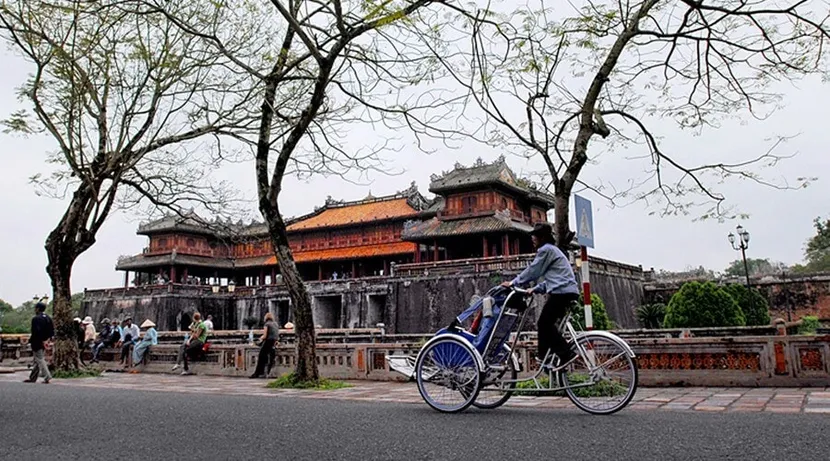
Origins and Evolution: The Birth of Vietnam’s Cyclo
French Colonial Influence and the Cyclo’s Invention
The story of the cyclo begins during Vietnam’s French colonial period, which stretched from the late 19th century until 1954. While cycle rickshaws existed in various forms throughout Asia, the distinctive front-facing passenger design of the Vietnamese cyclo represented a unique innovation that transformed urban transportation in Indochina.
Most historical accounts credit French engineer Pierre Coupeaud with inventing the cyclo in the early 1930s. Coupeaud, who lived in Vietnam, designed this new vehicle to improve upon the traditional pulled rickshaw by incorporating a bicycle mechanism that was more efficient and less physically demanding for the operator. His design placed the passenger seat in front of the driver rather than behind or to the side, as seen in rickshaws and pedicabs in other Asian countries.
The name “cyclo” itself reflects this French influence, deriving from the French word “cyclo-pousse” (literally “cycle-push”), though in Vietnamese it is called “xích lô,” a phonetic adaptation of the French term. This linguistic evolution mirrors the vehicle itself—a foreign concept that became thoroughly Vietnamese through adaptation and cultural integration.
The initial cyclos appeared on the streets of Saigon (now Ho Chi Minh City) around 1936, and the design quickly spread to Hanoi and other major Vietnamese cities. Their popularity grew rapidly for several reasons:
- The forward-facing passenger seat offered better views and a more comfortable ride
- The bicycle mechanism made them more efficient than hand-pulled rickshaws
- The design allowed for relatively easy navigation through narrow colonial-era streets
- The passenger compartment provided some protection from sun and rain
By the late 1930s, cyclos had largely replaced traditional pulled rickshaws in Vietnam’s urban centers, becoming the dominant form of hired transportation for both locals and French colonists.
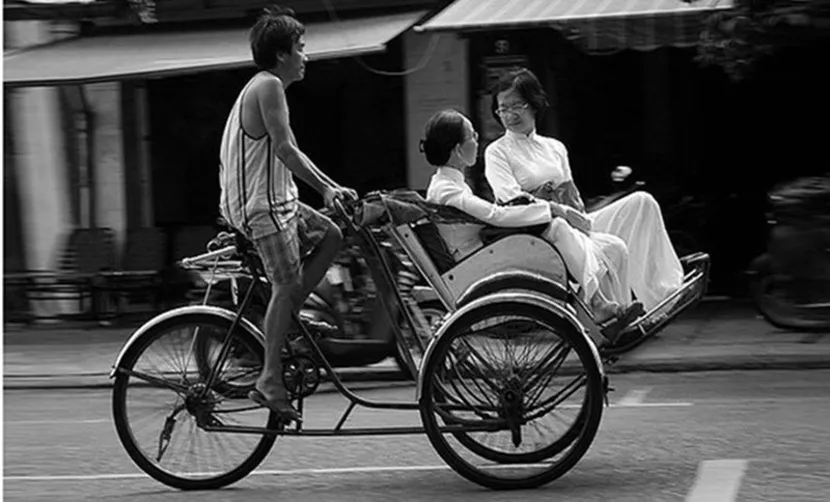
Design Variations Across Vietnam
As cyclos became established throughout Vietnam, regional design variations emerged that reflected local preferences, road conditions, and cultural influences:
Northern Style (Hanoi)
- Narrower profile to navigate Hanoi’s ancient, narrow streets
- More utilitarian design with simpler aesthetics
- Better adapted for cooler, sometimes rainy northern climate with rain covers
- Typically painted in darker, more subdued colors
Southern Style (Saigon/Ho Chi Minh City)
- Wider, more spacious passenger compartments
- More decorative elements and brighter color schemes
- Designed for the hot southern climate with sun shades
- Often featuring more elaborate upholstery and cushioning
Central Vietnam Style (Hue, Hoi An)
- A hybrid approach combining elements of northern and southern designs
- Often featuring distinctive local decorative elements
- Adapted for tourist use in these historically significant cities
These regional differences remain visible today and provide interesting insights into the local character of different Vietnamese cities. At VietRice Essence Restaurant, we sometimes share photographs of these regional variations with guests interested in Vietnamese cultural history, helping them understand the subtle differences they might notice while exploring different parts of the country.
The Golden Age: Cyclos in Post-Colonial Vietnam
From Colonial Luxury to Everyday Transportation
Following Vietnam’s independence from France in 1954, cyclos transitioned from being associated with colonial privilege to becoming a ubiquitous form of transportation for ordinary Vietnamese citizens. During the 1950s and 1960s, before the widespread adoption of motorbikes, cyclos served as essential transportation infrastructure in Vietnamese cities.
In Hanoi, under the socialist government of North Vietnam, cyclos were organized into cooperatives, providing regulated transportation services at standardized rates. In Saigon, before the end of the Vietnam War in 1975, cyclos operated in a more free-market environment, with independent drivers competing for passengers throughout the bustling city.
During this period, cyclos were used for virtually every urban transportation purpose:
- Daily commuting for office workers and students
- Shopping trips to markets and commercial districts
- Family outings and social visits
- Transportation of goods and small cargo
- Wedding processions and special celebrations
The versatility of cyclos made them indispensable in Vietnamese urban life. Unlike automobiles, which remained luxury items accessible only to the wealthy, cyclos provided affordable transportation for the growing middle class. Their ability to navigate narrow streets, operate without fuel, and carry surprisingly large loads made them perfectly adapted to Vietnam’s urban environment.
Cultural Significance During Wartime
Throughout the American War in Vietnam (known in the West as the Vietnam War), cyclos maintained their important role in civilian life, particularly in Saigon. They became a symbol of everyday Vietnamese resilience amid conflict, continuing to provide essential transportation even as the war intensified.
Cyclos also gained international recognition during this period through war photography and news coverage, becoming a visual shorthand for Vietnamese urban life in global media. Foreign journalists, diplomats, and military personnel often used cyclos to navigate Vietnamese cities, giving the humble vehicle an unexpected role in international relations.
In Hanoi, which experienced American bombing campaigns, cyclos sometimes served as mobile first aid stations or were used to transport supplies during air raids. The open design allowed for quick loading and unloading, making them valuable for emergency response in neighborhoods with narrow streets inaccessible to larger vehicles.
By the 1960s and early 1970s, the cyclo had become an integral part of Vietnam’s cultural identity—a distinctly Vietnamese adaptation of transportation technology that reflected the ingenuity and practicality of the Vietnamese people. This period represented the peak of the cyclo’s functional importance in Vietnamese society.
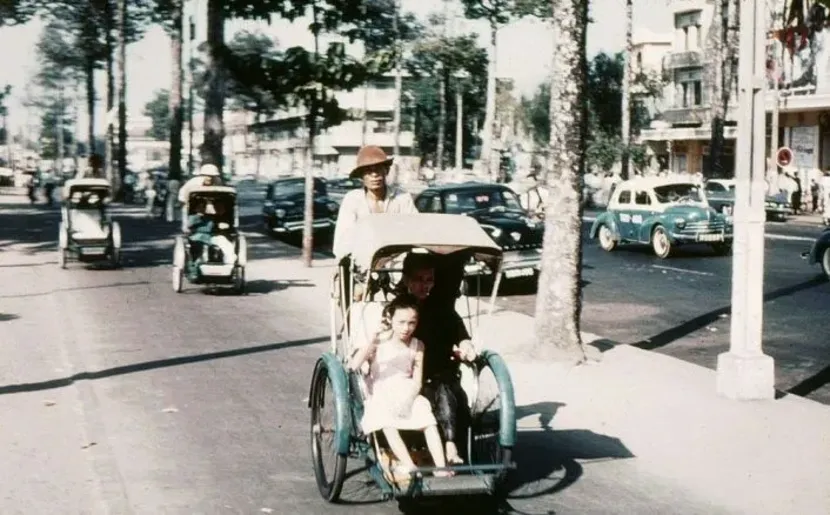
Changing Times: Cyclos in Modern Vietnam
Economic Reforms and Transportation Revolution
The implementation of Đổi Mới (Renovation) economic reforms beginning in 1986 transformed Vietnam, setting the stage for rapid modernization that would dramatically change the role of cyclos in Vietnamese society. As Vietnam opened to international investment and private enterprise, personal transportation options multiplied.
The most significant challenge to cyclos came from motorbikes, which surged in popularity during the 1990s. Offering greater speed, range, and personal autonomy, motorbikes quickly became the preferred transportation method for most Vietnamese urbanites. By the early 2000s, Vietnam had transformed into a “kingdom of motorbikes,” with cities like Hanoi and Ho Chi Minh City each hosting millions of two-wheeled vehicles.
This transportation revolution fundamentally changed the cyclo’s role:
- From primary transportation to specialty service
- From everyday utility to tourism and heritage experience
- From ubiquitous presence to protected cultural symbol
While the total number of cyclos declined dramatically, they never disappeared entirely. Instead, they found new purpose as representatives of Vietnamese cultural heritage and as unique tourism experiences.
Transition to Tourism and Cultural Heritage
As Vietnam’s international tourism industry developed in the 1990s and 2000s, cyclos found a new role as a distinctive way for visitors to experience Vietnamese cities. Unlike the efficient but impersonal experience of taxi travel, cyclo tours offered:
- An open-air perspective on urban landscapes
- A pace slow enough to absorb the sights, sounds, and smells of Vietnamese streets
- Direct interaction with a local cyclo driver
- A photogenic, “authentic” Vietnamese experience
Tourism authorities and local governments recognized the cultural value of cyclos and took steps to preserve them as heritage symbols. Cities like Hanoi, Hue, and Ho Chi Minh City established regulations for tourism cyclos, creating designated routes, standardized rates, and sometimes even specific designs or colors for cyclos operating in historic districts.
At VietRice Essence Restaurant, we often recommend authentic cyclo tours to our guests as an ideal first activity upon arriving in Vietnam. The relaxed pace and open-air experience helps visitors adjust to Vietnam’s vibrant street life while learning about urban landmarks from their cyclo driver’s perspective. Our Viet Rice Kitchen Cooking Class sometimes incorporates cyclo transportation to local markets, allowing participants to experience this traditional form of transport while gathering ingredients for their cooking lessons.
The Cyclo Driver: Keepers of Urban Knowledge
Life as a Cyclo Driver
Throughout the cyclo’s history, the men who pedaled these distinctive vehicles have formed a unique occupational community with their own traditions, knowledge, and place in Vietnamese society. Being a cyclo driver was never merely a transportation job—it represented a distinctive social role and way of life.
In the cyclo’s heyday from the 1950s through the 1980s, drivers typically followed one of two career paths:
- Full-time professional drivers who owned their vehicles and operated continuously in specific territories, often passing their routes and customer relationships to their sons or nephews
- Seasonal or situational drivers who turned to cyclo work during agricultural off-seasons or as a fallback occupation during economic hardship
The physical demands of the profession were considerable. Drivers typically pedaled for 8-12 hours daily, covering 20-30 kilometers while carrying passengers or goods that might weigh 150 kg or more. This required extraordinary physical stamina and resulted in distinctive physical development—experienced cyclo drivers were recognizable by their disproportionately muscular legs and lean upper bodies.
Despite these challenges, the profession offered significant advantages for men with limited formal education:
- Independence and self-employment
- Immediate daily income without need for startup capital
- Flexible working hours
- Social connection and camaraderie with other drivers
- Intimate knowledge of city geography and social life
Today’s remaining cyclo drivers are primarily older men who began their careers during the profession’s golden age. With fewer passengers and increased competition, contemporary drivers face economic challenges that their predecessors did not, though tourism has provided a valuable market niche.
Cyclo Drivers as Cultural Ambassadors
Beyond their transportation role, cyclo drivers have long served as informal cultural ambassadors and repositories of urban knowledge. Their constant presence on city streets makes them witnesses to both everyday life and historic events, giving many veteran drivers remarkable insights into Vietnam’s urban evolution.
For foreign visitors, cyclo drivers often become their first meaningful point of contact with everyday Vietnamese people. Despite potential language barriers, these interactions frequently create memorable cultural exchanges. Many drivers have developed informal tour guide skills, pointing out landmarks and sharing stories about city history with their passengers.
At Viet Rice Kitchen Cooking Class, we occasionally invite veteran cyclo drivers to share their perspectives with our guests, offering unique insights into how Vietnamese cities and food culture have changed over decades. These oral histories provide a street-level view of Vietnam’s remarkable transformation that complements the historical narratives found in museums and textbooks.
The Cyclo in Vietnamese Arts and Media
Literary and Cinematic Representations
The cultural significance of the cyclo extends well beyond its practical transportation function, as evidenced by its prominent place in Vietnamese literature, cinema, and visual arts. As a symbol of urban Vietnamese life and a metaphor for the nation’s journey through modernity, the cyclo has inspired numerous artistic works.
In literature, the cyclo appears in short stories and novels by renowned Vietnamese authors like Nguyen Huy Thiep and Duong Thu Huong, often representing the everyday struggles and resilience of ordinary Vietnamese people. The intimate perspective of the cyclo driver—witnessing but somewhat separated from the lives of his passengers—has provided a powerful narrative viewpoint for exploring Vietnamese society.
Vietnamese cinema has perhaps most effectively captured the visual and symbolic power of the cyclo. Most internationally recognized is Tran Anh Hung’s acclaimed 1995 film “Cyclo,” which won the Golden Lion at the Venice Film Festival. This dark, visually striking film uses the cyclo driver’s vulnerable position in urban society to explore themes of economic desperation, lost innocence, and adaptation to a rapidly changing Vietnam.
Other notable films featuring cyclos include:
- “The Scent of Green Papaya” (1993): Using cyclos to evoke 1950s Saigon
- “Three Seasons” (1999): Depicting cyclo drivers amid rapidly modernizing Ho Chi Minh City
- “The Vertical Ray of the Sun” (2000): Featuring cyclos as elements of Hanoi’s distinctive urban atmosphere
These artistic representations have helped cement the cyclo’s place in both Vietnamese cultural memory and international perceptions of Vietnam.

The Cyclo in Visual Arts and Design
Beyond literature and film, the cyclo has inspired visual artists, designers, and craftspeople. Its distinctive silhouette has become an immediately recognizable symbol of Vietnam, used in:
- Tourism promotional materials and logos
- Contemporary Vietnamese paintings and prints
- Souvenirs and handicrafts (miniature cyclo models are particularly popular)
- Graphic design elements in both commercial and governmental contexts
- Restaurant and café décor, including at VietRice Essence Restaurant, where vintage cyclo photographs adorn our walls
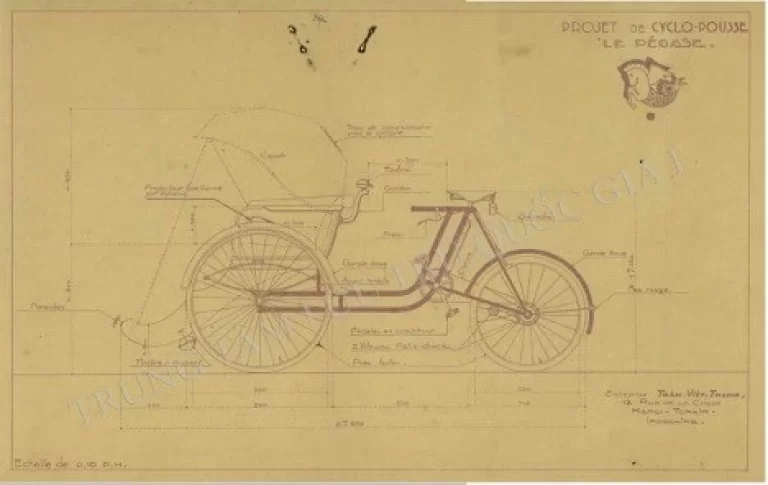
The cyclo’s visual appeal combines nostalgic connection to Vietnam’s past with a unique, instantly identifiable form that distinguishes it from other Asian rickshaw traditions. This has made it a favored motif for expressing Vietnamese identity in both traditional and contemporary contexts.
Preservation Efforts and Contemporary Challenges
Official Recognition and Protection
As cyclos transitioned from everyday transportation to cultural heritage, various Vietnamese authorities have implemented measures to preserve them as living cultural artifacts:
- Heritage designations for cyclos in historic city centers
- Licensing systems to maintain quality and authenticity
- Creation of cyclo associations to advocate for drivers’ interests
- Integration of cyclos into tourism development plans
- Documentation of cyclo history in museums and cultural centers
In Hanoi, the Ancient Quarter Management Board has worked to preserve cyclos as part of the historic district’s cultural landscape. In Hue, Vietnam’s former imperial capital, cyclos receive special heritage status in the city center. Ho Chi Minh City has established designated cyclo routes in historically significant areas, particularly around landmarks like the Opera House and Notre Dame Cathedral.
Environmental and Sustainability Considerations
In contemporary discussions about urban transportation, cyclos have gained new appreciation for their environmental benefits:
- Zero emissions and no fossil fuel consumption
- Minimal noise pollution compared to motorized transportation
- Efficient use of limited urban road space
- Sustainable, human-powered mobility
- Contribution to distinctive urban character rather than standardized development
As Vietnamese cities face increasing traffic congestion and air quality concerns, some urban planners and environmental advocates have proposed modern interpretations of the cyclo concept as part of sustainable transportation solutions. While traditional cyclos will likely remain primarily tourism-oriented, their fundamental design principles offer valuable insights for future urban mobility planning.
At VietRice Essence Restaurant, we highlight these sustainability aspects when recommending cyclo tours to environmentally conscious guests, noting that choosing a cyclo over a taxi or motorbike tour represents a more ecological way to experience Vietnamese cities.
Experiencing Cyclos as a Visitor to Vietnam
How to Enjoy an Authentic Cyclo Experience
For visitors to Vietnam seeking to experience this iconic form of transportation, several approaches offer authentic engagement with cyclo culture:
Guided Cyclo Tours Organized cyclo tours provide the most structured experience, typically lasting 1-3 hours and covering major landmarks in historic districts. These tours often include:
- English-speaking guides (either the driver or an accompanying guide)
- Predetermined routes highlighting architectural and cultural points of interest
- Historical context and stories about the areas visited
- Photography opportunities at scenic locations
Independent Cyclo Hire More adventurous travelers can hire cyclos independently at major tourist areas, negotiating routes and rates directly with drivers. This approach offers greater flexibility but requires basic communication skills or translation assistance. At VietRice Essence Restaurant, our staff can help guests arrange independent cyclo experiences and suggest interesting destinations beyond the standard tourist routes.
Cyclo as Transportation For short distances within historic city centers, cyclos can serve as practical transportation between attractions, restaurants, or shopping areas. This functional use often provides the most authentic experience, similar to how cyclos were traditionally used by Vietnamese people.
Cyclo Museums and Exhibitions Several Vietnamese cities now feature small museums or exhibits dedicated to cyclo history, offering deeper context for those interested in the cultural and historical significance of these vehicles. The Vietnamese Women’s Museum in Hanoi, for example, includes cyclos in its exhibition on changing urban lifestyles.
At Viet Rice Kitchen Cooking Class, we occasionally arrange cyclo transportation for our culinary market tours, allowing participants to travel between markets and food stalls in traditional style while learning about Vietnamese ingredients and cooking techniques.
Etiquette and Responsible Tourism
To ensure that cyclo experiences remain positive for both visitors and drivers, responsible tourism practices are essential:
- Agree on prices before beginning your journey
- Recognize the physical effort involved and keep trips to reasonable distances
- Tip drivers appropriately, especially if they provide informative commentary
- Ask permission before taking drivers’ photographs
- Consider the weather conditions and driver’s comfort
- Support regulated, licensed cyclo services rather than unofficial operators
Most importantly, approach the experience with respect for both the cultural significance of the cyclo and the individuals who maintain this tradition. Contemporary cyclo drivers are not living museum exhibits but working people practicing a traditional profession under challenging economic circumstances.
The Future of Vietnam’s Cyclos
Challenges and Adaptation
As Vietnam continues its rapid development, cyclos face ongoing challenges that will determine their future role in Vietnamese society:
Economic Viability With declining passenger numbers and increasing competition from modern transportation options, the economic sustainability of cyclo driving as a profession remains uncertain. Tourism currently provides the primary economic justification for cyclos’ continued existence, but this creates vulnerability to tourism market fluctuations.
Urban Development Pressures Modern urban planning priorities—wider roads, faster traffic flow, pedestrianized zones—can inadvertently squeeze cyclos out of city centers where they traditionally operated. Without specific accommodation in urban development plans, cyclos may find their operational areas increasingly restricted.
Aging Driver Population With few young people entering the profession, the knowledge and skills of cyclo driving risk disappearing as the current generation of elderly drivers retires. The physically demanding nature of the work, combined with limited economic rewards, makes recruitment of new drivers challenging.
Authenticity versus Commodification As cyclos become increasingly tourism-oriented, finding the balance between authentic cultural preservation and commercial adaptation presents ongoing challenges. Some tourism-focused cyclos now feature modifications like electric assistance, decorative elements, or comfort features that diverge from traditional designs.
Innovation and Evolution
Despite these challenges, several promising developments suggest potential paths forward for cyclos in contemporary Vietnam:
Heritage Tourism Integration Cities like Hue and Hoi An have successfully integrated cyclos into broader heritage tourism experiences, creating economically viable models that preserve traditional designs and operational practices. These approaches recognize cyclos as living heritage rather than mere transportation.
Modern Reinterpretations Some entrepreneurs and designers have created updated cyclo variants that maintain the iconic form while incorporating modern materials, electric assistance, or adaptive features. These innovations may help extend the cyclo tradition by making the profession more sustainable for a new generation of drivers.
Cultural Documentation and Education Museums, universities, and cultural organizations are increasingly documenting cyclo history, designs, and social significance, ensuring that knowledge is preserved even as the number of traditional cyclos decreases. Oral history projects recording veteran drivers’ experiences provide valuable cultural archives.
International Recognition Growing international appreciation for the cyclo as a uniquely Vietnamese cultural icon has strengthened domestic recognition of its heritage value. As with other traditional practices initially threatened by modernization but later recognized as cultural treasures, this international validation may contribute to stronger preservation efforts.
Conclusion: The Cyclo as Vietnam’s Living Heritage
The story of the Vietnamese cyclo offers a fascinating lens through which to view the country’s journey through the 20th century and into the 21st. From its origins in French colonial innovation to its adaptation as a distinctly Vietnamese cultural symbol, the cyclo embodies the creativity, resilience, and practical ingenuity that characterize Vietnamese culture.
Unlike artifacts preserved in museums, cyclos remain part of Vietnam’s living heritage—still operating on city streets, still pedaled by knowledgeable drivers, still offering their unique perspective on urban life. This living quality makes them particularly valuable as cultural ambassadors, providing visitors with an experience that engages all senses and creates genuine connections with Vietnamese traditions.
At VietRice Essence Restaurant and Viet Rice Kitchen Cooking Class, we celebrate the cyclo alongside Vietnamese culinary traditions as essential elements of the country’s cultural identity. We encourage our guests to experience cyclo journeys as complementary to their culinary explorations—both offering intimate, pace-appropriate ways to understand Vietnam’s rich heritage.
Whether viewed as transportation technology, cultural symbol, economic livelihood, or artistic inspiration, the cyclo has earned its place as one of Vietnam’s most distinctive contributions to global cultural heritage. Its future may look different from its past, but the essential spirit of the cyclo—human-powered, forward-facing, intimately connected to street life—continues to represent something uniquely and authentically Vietnamese in our rapidly changing world.
VietRice Essence Restaurant & Viet Rice Kitchen Cooking Class
Your gateway to authentic Vietnamese cultural experiences
https://vietriceessence.com/cooking-class/
http://vietricekitchen.com/

